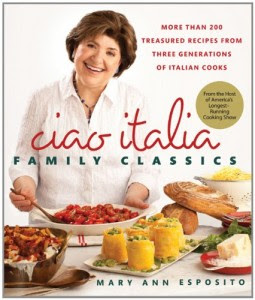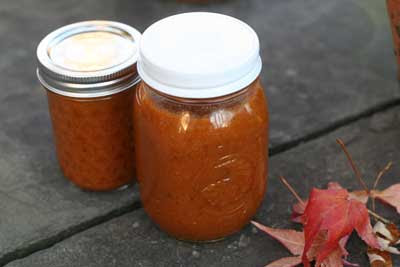 When it comes to Italian cuisine, Mary Ann Esposito is an institution. She is the host and creator of Ciao Italia with Mary Ann Esposito, the United States’ longest running cooking program which has been on the air since 1989. She is also the author of 12 Italian cookbooks and also has a website, www.ciaoitalia.com.
When it comes to Italian cuisine, Mary Ann Esposito is an institution. She is the host and creator of Ciao Italia with Mary Ann Esposito, the United States’ longest running cooking program which has been on the air since 1989. She is also the author of 12 Italian cookbooks and also has a website, www.ciaoitalia.com.In her twelfth cookbook, Ciao Italia Family Classics, Esposito admits that she is both a traditionalist and a minimalist as she strives to let the best ingredients shine on their own in all of her recipes. Strongly influenced by both of her grandmothers and her mother, the author has created an outstanding collection of recipes featuring many Sicilian and Neapolitan favorites. In addition to the more than 200 recipes, Esposito also includes a chapter entitled “Italian Pantry Basics” where she describes the key ingredients most commonly used in Italian kitchens. She also stresses the importance of planning meals and bringing the family back to the dinner table to eat together despite busy, hectic schedules. The author contends that eating together, in the Italian tradition, promotes conversation, togetherness, reassurance, and relaxation. She also talks about the importance of teaching children about good food so that they can make healthy choices as adults.
While reviewing Ciao Italia Family Classics, it became evident early on that this book is a must have cookbook for anyone who loves Italian Cuisine. Indeed, it was difficult to choose just three recipes from this book. They were all very appetizing and most were accompanied by amazing, mouth-watering photos. Each recipe also had an interesting anecdote in which Mary Ann Esposito draws from her rich Italian heritage to describe the origins of the recipe and its importance to her. We decided to try the Arancine Siciliane (Sicilian Rice Balls), Calzone di Ricotta alla Mamma (Mom’s Ricotta Cheese Calzones), and Cannoli alla Nonna Saparito ( Nonna Saparito’s Cannoli). Esposito’s recipe for the risotto is delicious enough, but to then to roll it into balls and deep fry it takes it to ethereal levels. The Arancine Siciliane is an amazing side dish or appetizer that you absolutely have to try. The Ricotta Calzones were equally delicious. This is a simple recipe that lends itself to experimentation. There are a multitude of vegetables and meats that could be added to the cheese calzone base to create incredible entrees. For dessert we tried an Italian classic, cannoli. This was also relatively easy recipe that resulted in a delicious dessert with a light crispy shell combined with a cool, creamy, chocolaty filling. It was difficult to eat just three of these!
We give Ciao Italia Family classics 5 out of 5 stars. It is packed with recipes of traditional Italian favorites that are easy and accessible. In addition, most recipes include beautiful photographs and interesting descriptions. It would be a cherished collection of recipes for anyone that loves Italian cuisine.

 This is an easy recipe for a versatile, hot and sweet, Louisiana Habanero Hot Sauce. It works great as a regular hot sauce but it is also good to use as a dipping sauce for
This is an easy recipe for a versatile, hot and sweet, Louisiana Habanero Hot Sauce. It works great as a regular hot sauce but it is also good to use as a dipping sauce for  United States
United States  Louisiana [
Louisiana [  From
From  Italy [
Italy [ 
 France [
France [  This curry has an intense heat of chili running through it, which cuts through the rich, creamy coconut and sweet pumpkin. Use butternut squash if you can't get ahold of pumpkin.
This curry has an intense heat of chili running through it, which cuts through the rich, creamy coconut and sweet pumpkin. Use butternut squash if you can't get ahold of pumpkin. Sri Lanka [
Sri Lanka [  Limoncello is an Italian citrus based liqueur that is usually served before or after meals. It originates from the Amalfi Coast region of Italy where lemons grow in abundance. Limoncello is usually served chilled and it is very popular in Italy during the warmer summer months. This traditional version of limoncello is lemon-based but similar liqueurs can be made from other citrus fruits. If you have the patience (this recipe takes about 35 days to make), limoncello is an easy liqueur to make at home. Staying true to this Italian classic, we used I Spirit Italian Vodka for this recipe.
Limoncello is an Italian citrus based liqueur that is usually served before or after meals. It originates from the Amalfi Coast region of Italy where lemons grow in abundance. Limoncello is usually served chilled and it is very popular in Italy during the warmer summer months. This traditional version of limoncello is lemon-based but similar liqueurs can be made from other citrus fruits. If you have the patience (this recipe takes about 35 days to make), limoncello is an easy liqueur to make at home. Staying true to this Italian classic, we used I Spirit Italian Vodka for this recipe.



 It’s been 10 years since the first edition of 150 Best Slow Cooker Recipes, by Judith Finlayson, was released. The second edition of this slow cooker “Bible” has been revised by the author to include new, healthier recipes and to upgrade many of the existing favorites. Finlayson has kept about 100 of the original recipes and added new dishes that include whole grains, fish and seafood, and vegetarian and vegan dishes as well. In addition to these new recipes, the book has retained many of the old classics including 15 different recipes for chili.
It’s been 10 years since the first edition of 150 Best Slow Cooker Recipes, by Judith Finlayson, was released. The second edition of this slow cooker “Bible” has been revised by the author to include new, healthier recipes and to upgrade many of the existing favorites. Finlayson has kept about 100 of the original recipes and added new dishes that include whole grains, fish and seafood, and vegetarian and vegan dishes as well. In addition to these new recipes, the book has retained many of the old classics including 15 different recipes for chili. Calvados is the famous apple brandy of Normandy, and the
Calvados is the famous apple brandy of Normandy, and the  From
From 
 Spain [
Spain [  Nonna Saporito could do no wrong in her kitchen. She could wield a cleaver like a pro, cut up a chicken lickety-split, and roll out pasta without breaking a sweat. Her signature dish, chicken in wine, is to this day my very favorite and one that I have never been able to duplicate in taste. Never! And when she served it, she also made arancine-fried rice balls. I devoured them. Arancine are traditional Sicilian street food that has its beginnings in many foreign cultures. The rice and saffron from the Arabs, the sheep's milk cheese from the Greeks, ragú from the French, and tomatoes from the Spanish. No wonder they are so good! Do not attempt to make these with regular rice. Make them with Arborio, the short-grain, starchy rice used to make risotto. It has the heft to stand up to frying.
Nonna Saporito could do no wrong in her kitchen. She could wield a cleaver like a pro, cut up a chicken lickety-split, and roll out pasta without breaking a sweat. Her signature dish, chicken in wine, is to this day my very favorite and one that I have never been able to duplicate in taste. Never! And when she served it, she also made arancine-fried rice balls. I devoured them. Arancine are traditional Sicilian street food that has its beginnings in many foreign cultures. The rice and saffron from the Arabs, the sheep's milk cheese from the Greeks, ragú from the French, and tomatoes from the Spanish. No wonder they are so good! Do not attempt to make these with regular rice. Make them with Arborio, the short-grain, starchy rice used to make risotto. It has the heft to stand up to frying. To the French, this is comfort food - a long-simmered dish that evokes warm memories of childhood. To North Americans, it's great bistro food - flavorful and hearty, perfectly suited to a full-bodied red wine and lively evenings with friends. Either way, it's perfect for the slow cooker and great as a leftover since it's even better reheated. Serve with new potatoes in their skins, buttered noodles or plain white rice and a simple green vegetable such as beans or broccoli.
To the French, this is comfort food - a long-simmered dish that evokes warm memories of childhood. To North Americans, it's great bistro food - flavorful and hearty, perfectly suited to a full-bodied red wine and lively evenings with friends. Either way, it's perfect for the slow cooker and great as a leftover since it's even better reheated. Serve with new potatoes in their skins, buttered noodles or plain white rice and a simple green vegetable such as beans or broccoli.